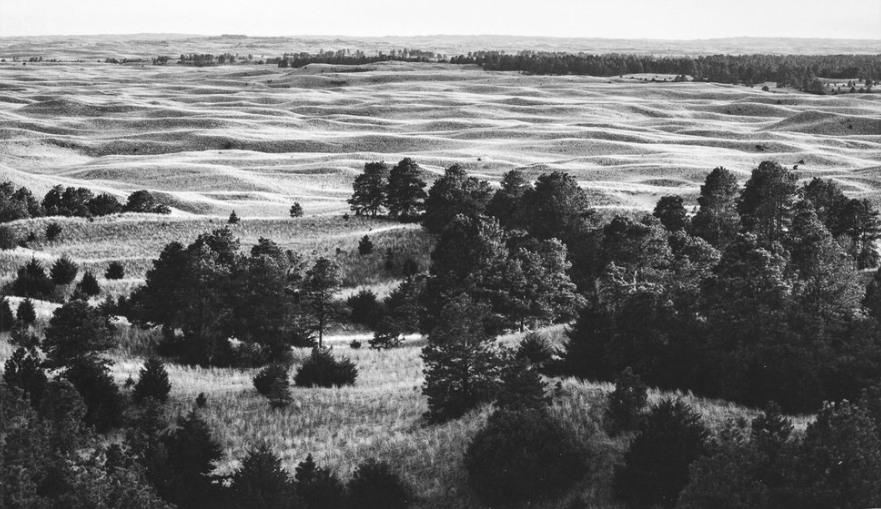
Dana Fritz’s latest book, “Field Guide to a Hybrid Landscape,” will be published by the University of Nebraska Press in January.
In the book, Fritz, professor of art, traces the evolution of the Bessey Ranger District and Nursery of the Nebraska National Forest and Grasslands, or the Nebraska National Forest at Halsey, as it is more widely known. It is the largest hand-planted forest in the Western Hemisphere, and formerly in the world.
Her contemporary photographs of the unique ecosystem are combined with environmental essays, maps and historical photographs from the U.S. Forest Service archives to inform the reader of the complex environmental and natural history of the site.

“I organized the photographs into chapters that make visible the forces that shaped the Bessey Ranger District — sand, wind, water, planting, thinning, fire, decomposition and sowing,” Fritz said. “I noticed human-made patterns such as rows and non-human patterns such as waves. These patterns appear at multiple scales throughout the photographs in the book. I thought about contrasts, including grass and trees, empty and full, light and dark, native and introduced. Using black and white photography to tell this story emphasizes these patterns and differences.”
The book features Fritz’s photography, as well as essays by Katie Anania, assistant professor of art history; Rebecca Buller, associate professor of practice in geography; and Rose-Marie Muzika, director of science at the Carnegie Museum of Natural History in Pittsburgh, as well as maps and a timeline by Salvador Lindquist, assistant professor of landscape architecture.
“I wanted the book to have multiple perspectives and an interdisciplinary approach,” Fritz said of the essayists.
At 5:30 p.m. Feb. 23 at the Center for Great Plains Studies, a panel discussion will take place with Fritz, Anania, Buller, Muzika and Lindquist, moderated by author and journalist Carson Vaughan.
Located in the Sandhills of central Nebraska, the forest was established in 1902 by Charles E. Bessey, who believed the area to have once had a natural forest and as an experiment to see if forests could be recreated in treeless areas of the Great Plains to be used as a national timber reserve. Bessey was professor of botany at the University of Nebraska and served as chancellor of the university from 1888 to 1891, and again from 1899 to 1900.
“I wanted to focus on a project that would help me understand our environment,” Fritz said. “The more I studied the forest, the more I realized how complex it is and how we can learn a lot from it. It might be a specific place and time in Nebraska, but it doesn’t mean we can’t apply it to other places.”
The forest was initially created to try to change the local climate.
“Bessey thought of it as a forest emergency, and if they didn’t plant trees, they were not going to have any forests,” Fritz said. “His mantra was plant trees. But also, they just didn’t seem to appreciate the Sandhills, and they didn’t appreciate how the Sandhills came to be without trees through wildfire and indigenous cultural fire practices.”
Fritz began photographing the forest in 2017 and continued through 2021. She is grateful for the support she received for the project from the U.S. Forest Service staff at the Bessey Ranger District and Nursery.
“I contacted them to let them know what I was doing because I also wanted to learn about it,” Fritz said. “Richard Gilbert, who is the nursery manager there, met me the first time I went out there and showed me around in an incredibly generous way. He also showed me the nursery, which grows millions of trees a year.”
She also collaborated with Todd Duncan and Duncan Aviation to complete some aerial photography of the forest, which is included in the book. It was her first experience with aerial photography.
“I was kind of terrified, but I had to push that aside because this was an amazing opportunity,” Fritz said. “And it was a revelation. It’s like looking down at the map in real time. It’s incredible. To see a place I’ve been so many times on the ground and studied the map so intensely, and then to see it from the air. It was so thrilling.”
She thought she had completed the project when it went to press. But as the book was going to press, two major fires devastated the forest this year, including the Bovee Fire this fall that scorched more than 18,000 acres in and near the Nebraska National Forest, damaging the Scott Lookout Tower and destroying the Nebraska State 4-H Camp near Halsey.
“It’s a radical transformation, and that’s really what fire is,” Fritz said. “It’s transformative. It’s powerful. But it happened to be extremely destructive this time because it caught the infrastructure, and it caught the forest at a very dry time.”
Fritz returned to the forest to take photos after each fire this year. She plans to return again soon and create a “postscript” to her work, which is currently on display at the Great Plains Art Museum through March 11 and features 42 prints.
She’s interested to see what comes back after the fire.
“I hope that there’s going to be a lot of snow. When I go back in the spring, I’ll see what comes up,” Fritz said. “There might be little trees. It’s hard to tell that early. The grass will probably come back right away. So that will be interesting to see if the forests is resilient or if the grasslands prevail. I’m not a scientist. I’m not an ecologist. I’m just an artist who’s trying to pay attention to this.”
Fritz’s book received support from a University of Nebraska–Lincoln’s Office of Research and Economic Development Arts and Humanities Research Enhancement Grant, Hixson-Lied College of Fine and Performing Endowment faculty grants, and the J.M. Kaplan Fund.
“I couldn’t even consider doing this without that kind of help,” Fritz said. “I had a lot of support from UNL, and I’m really grateful for that.”







